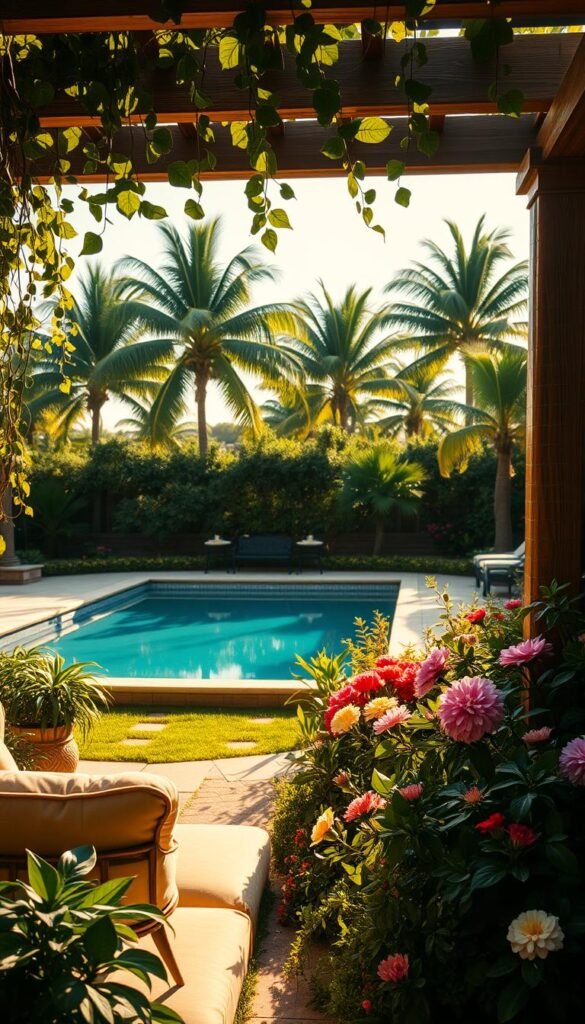Your backyard is more than just grass and patio furniture—it’s a canvas for creating memories. Today’s homeowners treat this area as an extension of their homes, blending relaxation, play, and entertainment into one versatile zone. Whether you’re hosting summer cookouts or enjoying quiet mornings with coffee, thoughtful design can turn ordinary yards into personalized retreats.
You don’t need a sprawling lawn or unlimited funds to make magic happen. Even compact urban spaces can become inviting escapes with clever layouts and multi-functional features. From cozy fire pits to vertical gardens, small tweaks often deliver big impact.
This guide walks you through practical steps to reimagine your property. Learn how to assess your site’s potential, choose designs that match your lifestyle, and balance DIY projects with professional expertise. We’ll focus on creating zones for dining, play, and relaxation—all while boosting your home’s curb appeal.
Ready to transform your space? Let’s explore how smart planning turns basic yards into year-round destinations. You’ll discover solutions for every budget and vision, ensuring your outdoor area reflects what matters most to you.
Understanding Your Outdoor Space
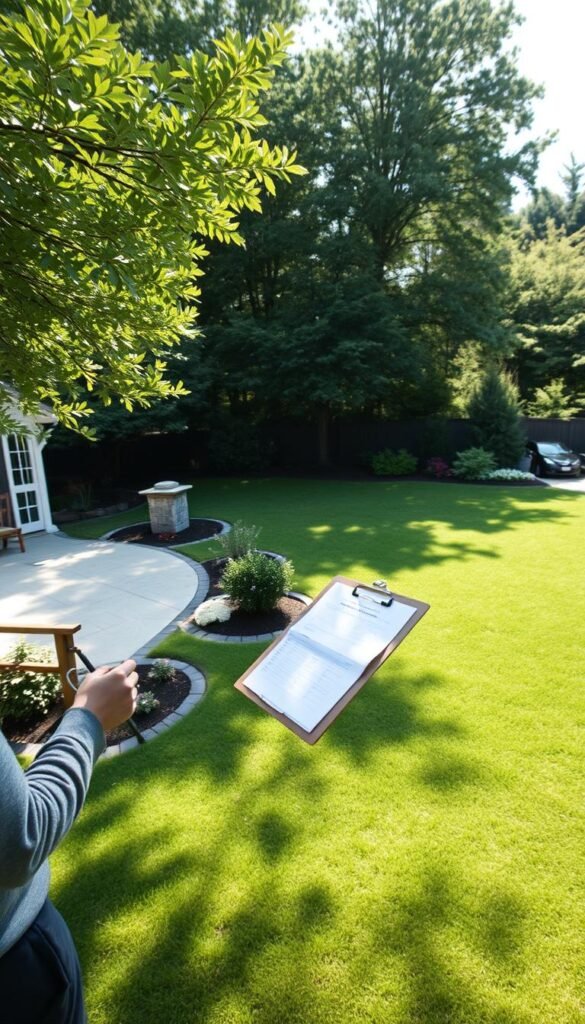
Every great outdoor project begins with understanding what you’re working with. Before picking plants or patio furniture, take time to map your terrain’s unique characteristics. This groundwork ensures your plans align with reality while avoiding costly surprises later.
Assessing Your Yard’s Shape and Size
Grab a tape measure and sketchpad first. Measure twice, design once isn’t just a carpentry rule—it applies to landscaping too. Note slopes that might affect drainage or limit seating areas. A 10-degree incline could mean terracing becomes essential for plant beds.
Sunlight patterns dictate more than garden choices. That west-facing corner baking in afternoon heat? Perfect for a fire pit zone but risky for delicate perennials. Track shadows throughout the day using free apps like Sun Seeker to optimize activity zones.
Identifying Existing Features and Challenges
Mature trees aren’t just shade providers—their root systems might limit digging. Can that cracked concrete path become rustic stepping stones? Repurposing saves money and adds character. Mark utility lines with spray paint to avoid hitting pipes during installations.
Watch for soggy spots after rains—they signal drainage issues needing French drains or rain gardens. Privacy gaps? Existing fences might need companion plantings rather than full replacements. By solving these puzzles early, you’ll create designs that work with your land, not against it.
Planning Your Dream Backyard
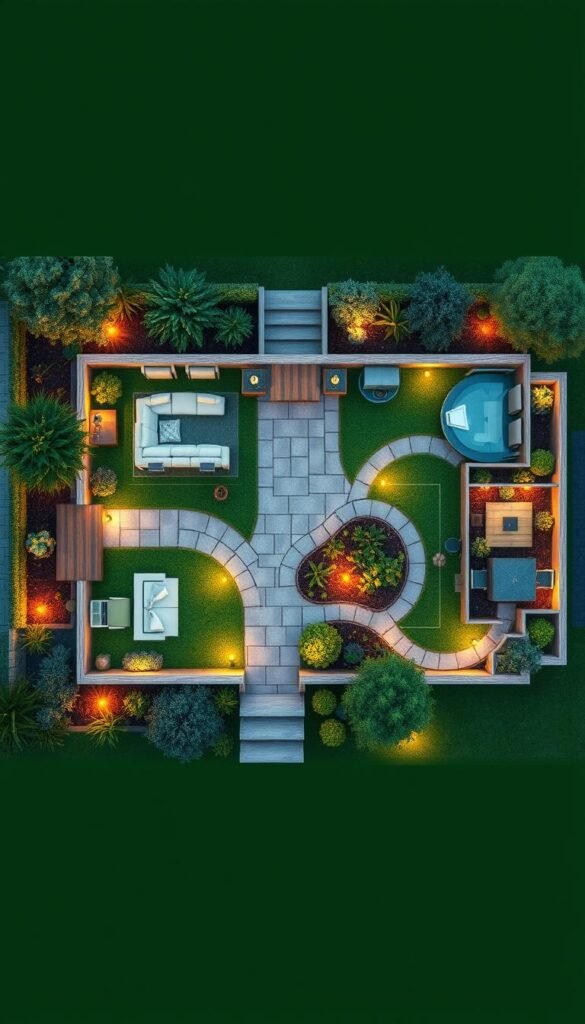
Crafting a backyard that suits your lifestyle requires thoughtful prioritization. Start by asking: “What moments do I want to create here?” Maybe it’s Friday pizza nights around a fire table or watching kids chase lightning bugs. Your answers shape everything that follows.
Defining Your Priorities and Functions
Grab sticky notes and list every activity your family enjoys. Hosting dinners? Growing tomatoes? Sunbathing? Rank these by frequency. Multipurpose zones save space—a dining patio can moonlight as a board game arena. One homeowner combined a sandbox with removable covers to create an adult cocktail area at dusk.
Leave breathing room between activity areas. A landscaper once advised:
“Design for how you live now, but leave space for how you might grow.”
This approach prevents overcrowding while accommodating future changes like swing sets or hot tubs.
Budgeting and Phasing Your Upgrades
Major projects don’t need to happen overnight. Break them into phases:
| Phase | Cost Range | Key Features |
|---|---|---|
| Year 1 | $2K-$5K | Patio stones, container gardens, string lights |
| Year 2 | $3K-$8K | Pergola, built-in seating, irrigation system |
| Year 3+ | $5K-$15K | Outdoor kitchen, water feature, mature trees |
Research materials early—concrete pavers often cost 40% less than natural stone but offer similar durability. Time installations around plant dormancy periods to give greenery its best start. Remember: Permits for structures like decks can take weeks, so factor that into timelines.
Design Principles for Outdoor Living
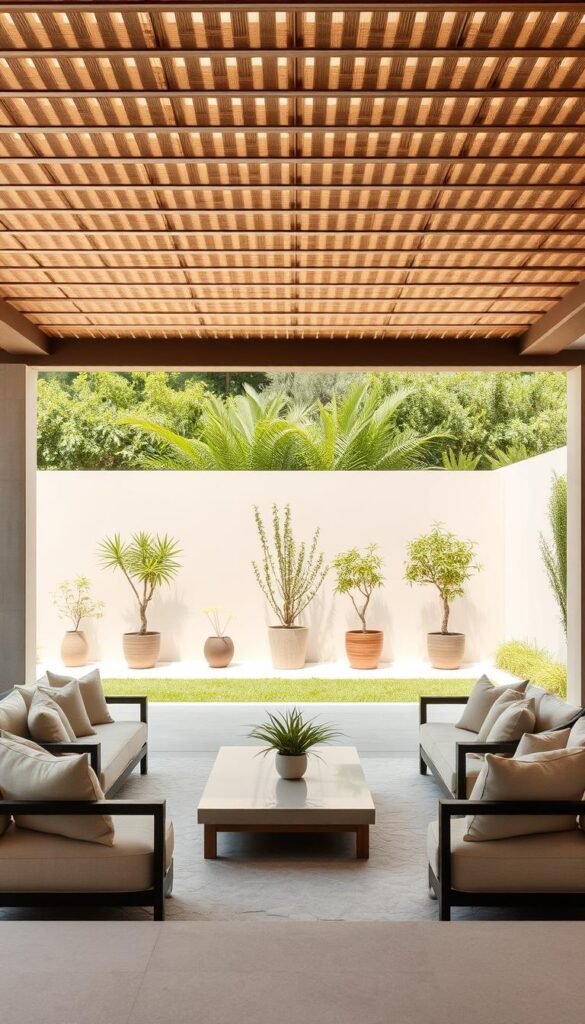
Smart design transforms ordinary yards into extensions of your lifestyle. By applying intentional layout strategies, you’ll create zones that feel both connected and purpose-driven. Let’s explore how to balance openness with cozy intimacy while maximizing every square foot.
Creating a Balanced Layout
Think of your property as a series of interconnected activity areas. A dining spot needs at least 36 inches around tables for chairs to slide out comfortably. Leave 48-inch-wide pathways between zones—enough for two people to walk side by side without brushing against plants.
One landscaper shares a golden rule:
“If it feels cramped on paper, it’ll feel worse in real life.”
Use curved walkways to slow movement and create natural sightlines. Place taller structures like pergolas near property edges to keep sightlines open in central gathering spots.
Dividing Your Space into Garden Rooms
Separate “rooms” make compact yards feel expansive. Try these division methods:
- Partial screens: Climbing roses on lattice panels filter light while maintaining airflow
- Level changes: A 12-inch elevation shift with retaining walls defines a fire pit zone
- Plant borders: Ornamental grasses in staggered rows create soft visual breaks
Keep transitions fluid—a gravel path dotted with thyme connects a lounge area to veggie beds. Semi-open dividers like trellises allow glimpses into neighboring zones, sparking curiosity without overwhelming the senses.
Creative Backyard Garden Ideas
Material combinations hold surprising power to redefine your space. When chosen thoughtfully, they can trick the eye into seeing more depth or create seamless transitions between zones. The key lies in balancing contrasts—think smooth concrete against pebbled gravel or weathered wood beside polished metal.
Mixing Textures and Materials
Start by pairing durable surfaces with softer accents. Extending a concrete patio with pea gravel adds modern flair without breaking the bank. One homeowner saved 30% on costs by using reclaimed bricks as edging for their herb beds—proving creativity often trumps big budgets.
Simple tweaks make spaces feel larger. Removing bulky deck railings opens sightlines, while crisp edges between lawns and planting areas add polish. As one designer notes: “Clean lines act like invisible walls, organizing your layout without physical barriers.”
Consider these combinations:
- Rustic stone pavers surrounded by feathery ornamental grasses
- Sleek corten steel planters filled with trailing ivy
- Recycled glass mulch sparkling beneath drought-tolerant succulents
Your choices should echo your home’s architecture while expressing personal taste. For those seeking gardening aesthetic inspiration, blend textures that tell your story—maybe smooth river rocks from childhood vacations or terracotta pots reminiscent of family heirlooms.
Remember: contrast creates interest, but cohesion keeps it relaxing. Limit material types to three per zone, repeating one element (like wood tones) throughout different areas to unify the design.
Incorporating Natural Elements and Plants
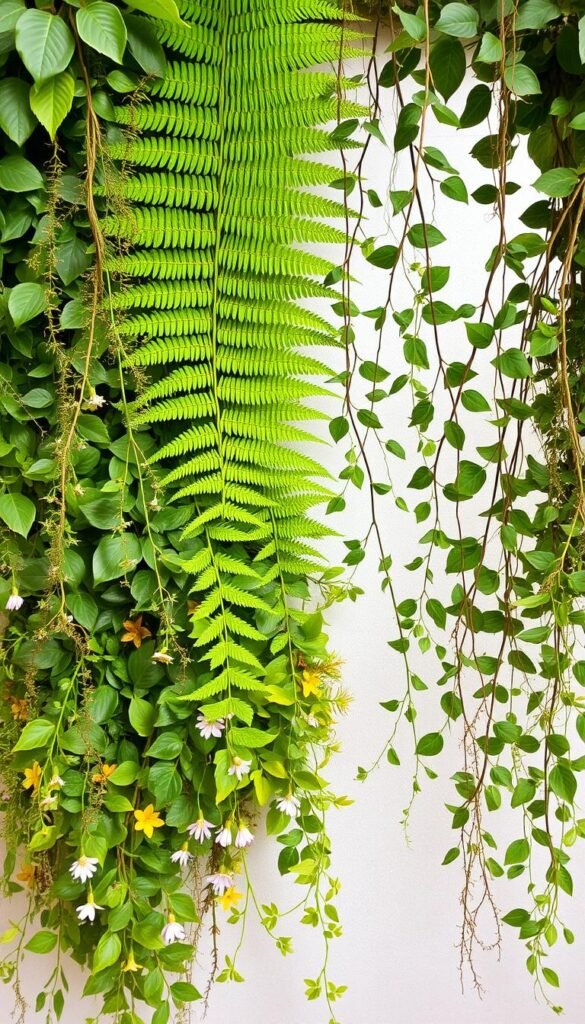
Nature offers the perfect balance of function and beauty when shaping your space. By working with your environment rather than against it, you’ll create a vibrant ecosystem that thrives with minimal effort.
Selecting Native and Seasonal Species
Start by matching plants to your yard’s conditions. Clay soil? Try purple coneflowers. Sandy patches? Rosemary thrives there. Local nurseries often label native species—like milkweed for monarch butterflies—that support pollinators while needing less water.
Seasonal picks keep your space lively year-round. Pair spring-blooming redbud trees with summer black-eyed Susans and fall-blooming asters. One gardener combined winterberry holly shrubs with ornamental grasses for winter texture—a smart move for four-season appeal.
Layering Plants for Privacy and Beauty
Think vertically when arranging greenery. Tall oakleaf hydrangeas form a mid-level screen, while creeping phlox carpets the ground beneath them. This approach creates depth and hides fence lines naturally.
For quick privacy, stagger evergreen shrubs like arborvitae behind flowering perennials. As one landscaper notes: “Layered designs do double duty—they’re pretty and practical.” Don’t forget edible layers—blueberry bushes add tasty structure!
Want more inspiration? Explore backyard garden ideas that blend beauty with eco-smart choices. Small spaces shine too—check out creative container gardens perfect for patios or balconies.
Elevating Your Backyard with Hardscape Features
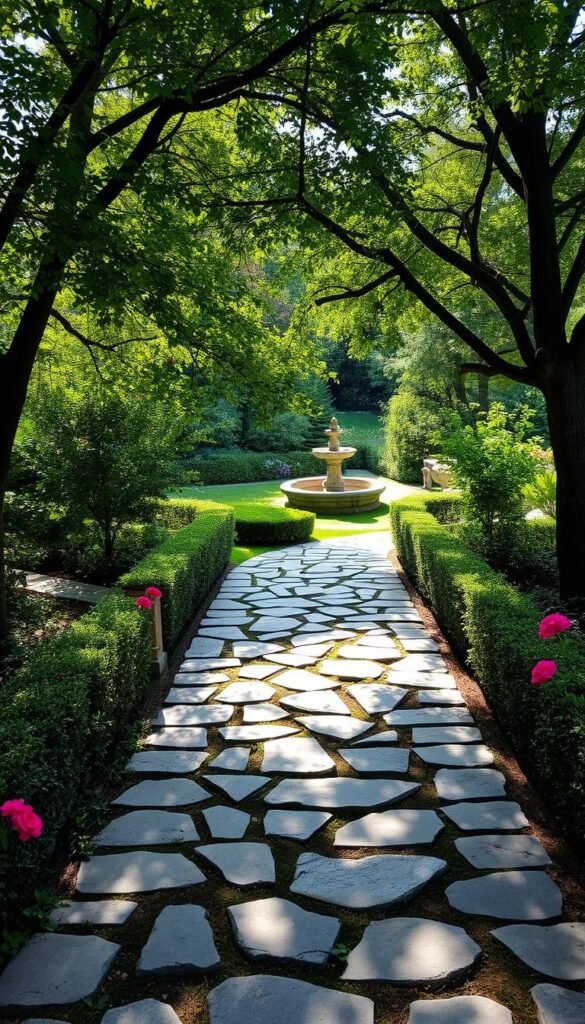
Hardscape elements bring structure and charm to your outdoor areas. While plants add color, materials like stone and pavers create the “bones” of your design. These features guide movement, define zones, and add year-round visual interest—even when gardens sleep.
Stone Walkways and Decorative Pavers
Transform your yard’s flow with purposeful pathways. Scatter flat stones between your patio and veggie patch for a rustic trail, or lay geometric pavers to frame a fire pit. Well-placed paths naturally draw eyes—and feet—to your property’s best features. A neighbor turned their muddy side yard into a welcoming entrance using irregular slate pieces from a local quarry.
Concrete pavers offer modern versatility. They come in shapes mimicking wood planks or cobblestones, often at half the cost of natural materials. For a cottagecore aesthetic, try circular stepping stones surrounded by creeping thyme. One homeowner created a winding gravel path edged with lavender, blending practicality with fairytale charm.
Keep installations simple. Use a level and rubber mallet to set stones flush with the ground. Leave 1-2 inch gaps between pavers for low-growing groundcovers like sedum. As a landscaper advises:
“Let the land guide your layout—curve paths around tree roots, not through them.”
This approach preserves mature trees while adding character.
Enhancing Privacy Through Landscaping
Privacy transforms your yard into a personal sanctuary where relaxation comes naturally. Urban settings often leave you feeling exposed, but strategic plantings and structures can create cozy, secluded areas without sacrificing style.
Natural Barriers That Work With Your Space
Start by identifying sightlines from neighboring windows—especially second-story views. A quick walk around your yard at different times reveals where coverage matters most. One homeowner discovered their breakfast nook was visible from three nearby balconies!
Swap plain fences for dynamic alternatives:
- Climbing roses on powder-coated steel trellises
- Bamboo screens that rustle soothingly in breezes
- Mixed hedges combining evergreen boxwood with flowering lilacs
Fast-growing grasses like maiden silvergrass reach 6 feet tall in one season. Pair them with young arborvitae trees spaced 4 feet apart—they’ll form a dense green wall within two years. As a landscaper notes:
“Living screens improve air quality while hiding AC units or trash bins.”
For instant coverage, try layered planters with trailing ivy and upright ferns. Maintain accessibility by leaving 18-inch gaps between screens and seating zones. Remember: native species like wax myrtle need less watering and naturally resist local pests.
Your hedges should match your lifestyle. Busy families might prefer slow-growing varieties needing trimmer use only twice yearly. Those wanting seasonal drama could plant hydrangea borders that bloom from spring through fall.
Maximizing Outdoor Living in Small Yards
Small yards hold big potential when you reach upward instead of outward. Vertical solutions let you grow food, flowers, and privacy screens without sacrificing precious square footage. The trick lies in layering greenery at different heights to create depth and purpose.
Smart Vertical Structures
Trellises and arbors do triple duty—they support climbing plants, define zones, and add architectural interest. Try sweet pea vines on a cedar lattice for spring color or passionflower on metal arches for tropical vibes. One gardener trained kiwi vines across a pergola, creating edible shade over their bistro set.
Elevated containers turn walls into living art. Mix trailing plants like petunias with upright herbs in stacked planters. For vibrant color bursts, pair dwarf sunflowers with purple basil in matching ceramic pots. As one designer notes:
“Your eyes naturally follow vertical lines upward, making spaces feel larger than they are.”
Container Creativity
Think beyond basic pots. Hang macramé planters from balcony ceilings or mount window boxes on shed eaves. Repurpose old ladders as tiered stands for succulents. Even that awkward corner under stairs can host a vertical herb garden using pocket planters.
- Use tall, narrow containers to frame doorways without blocking pathways
- Group small pots on shelves to create “green curtains” along fences
- Install self-watering systems in hard-to-reach hanging baskets
Raised beds solve drainage issues while adding height variation. Line them with strawberries along the edges and tomatoes in the center for a snackable display. Your yard’s limitations become launchpads for innovation.
Blending Indoor and Outdoor Living Spaces
The magic happens when your home’s interior flows effortlessly into nature. Large sliding glass doors or folding window walls erase boundaries, letting sunlight dance across both spaces. Choose weather-resistant furniture that mirrors indoor styles—a wicker sofa with plush cushions creates continuity between your den and deck.
Extend your design language outside through color and texture. Match patio umbrellas to living room throw pillows, or repeat kitchen cabinet finishes in outdoor storage benches. One homeowner painted their pergola beams the same charcoal gray as interior door frames, creating a cohesive visual story.
Practical touches enhance the blend. Install an outdoor rug under dining sets to mimic cozy breakfast nooks. Add ceiling fans to covered porches for air circulation like your family room. Even small details matter—using identical cabinet pulls indoors and out reinforces connection.
For true harmony, treat exterior zones as additional rooms. Layer lighting with string bulbs and pathway markers for evening ambiance. Place side tables between lounge chairs to hold drinks, just like your coffee table setup. This seamless transition makes every square foot feel intentional and lived-in.

